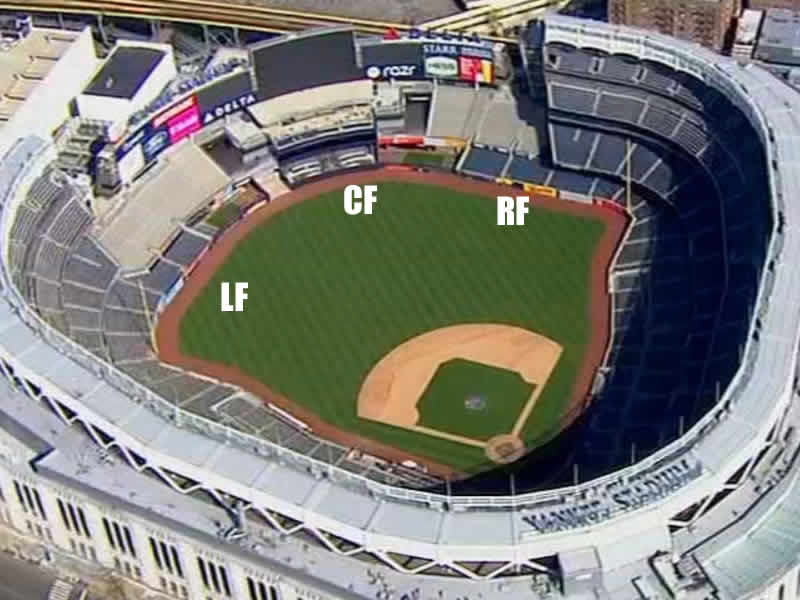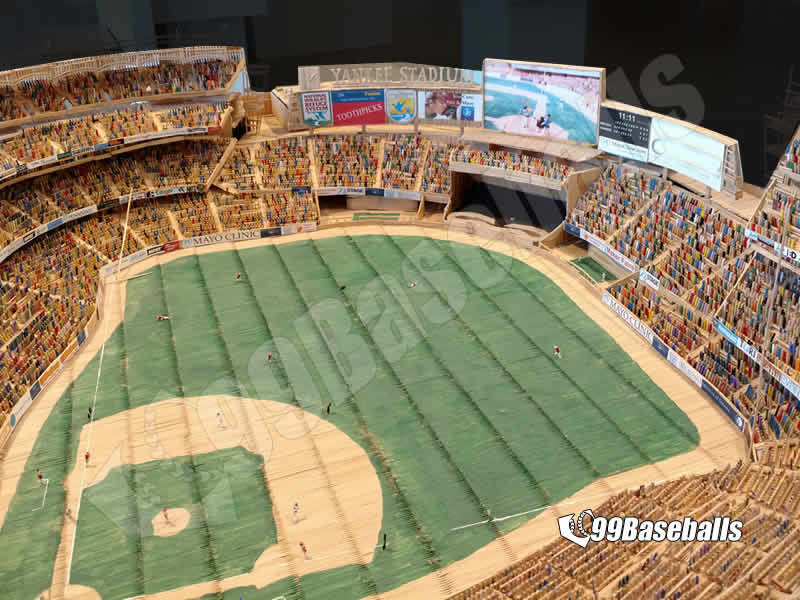- Foul lines in baseball are boundary markers that extend from home plate through first and third bases in the infield and stretch to the outfield wall.
- Baseball foul lines separate fair territory from foul territory, and the entire line width is part of fair territory.
- The accepted standard on the thickness of a foul line in baseball is 4″ wide (the MLB rule book does not specify the actual width).
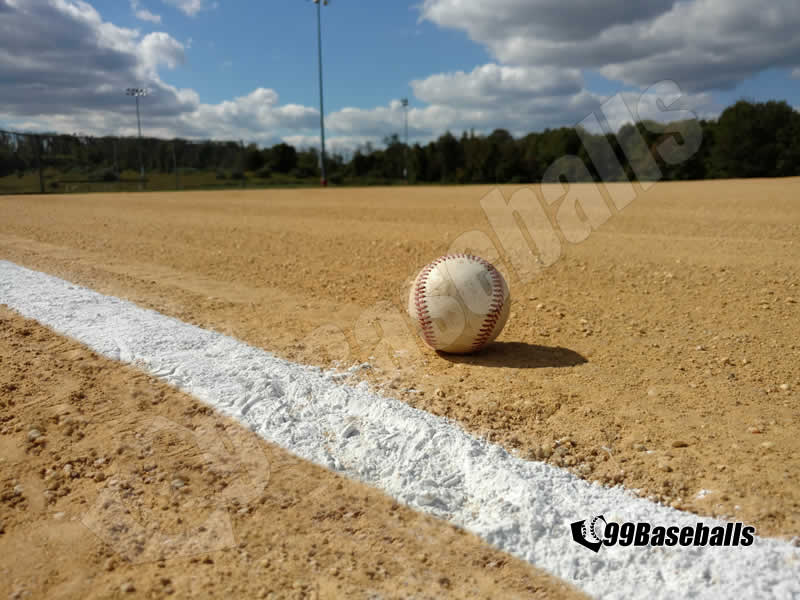
The first time I walked into Yankee Stadium, I could not believe how big it was! The green grass, the blue seats, the sound of people cheering, and the sight of a giant chalk line.
This crisp, thick straight white line seemed to stretch forever, and I wondered, how did they draw it so straight?
As a child, I remember my lines being wavy when I tried to draw a straight line on a playground! Since then, I have learned much more about baseball foul lines and how they are like an invisible wall, helping to decide what happens when a ball lands on a particular spot.
Let’s find out how the foul line in baseball came about, the materials used to draw the lines in youth and professional leagues, the dimensions, and more.
What is inside this post
- Foul Lines – Understanding Standards and Specifications
- Infield Foul Line Dimensions – How Far Does it Go?
- The Outfield Foul Line – First or Third Base to Outfield Wall
- Foul Poles – Material, Height, and Positioning
- Commonly used Marking Materials
- Laying Down the Line – Tips for Coaches
- Takeaways
- Frequently Asked Questions (FAQ)
- You May Also Like
Foul Lines – Understanding Standards and Specifications
American baseball has been around for over 150+ years and there seems to be a rule for every minute situation.
Curiously, when it comes to baseball foul lines, the Official Baseball Rules (OBR) issued by Major League Baseball do not have any rules on the width of these two lines, marking material selection, or for that matter, the width of the batter’s boxes.
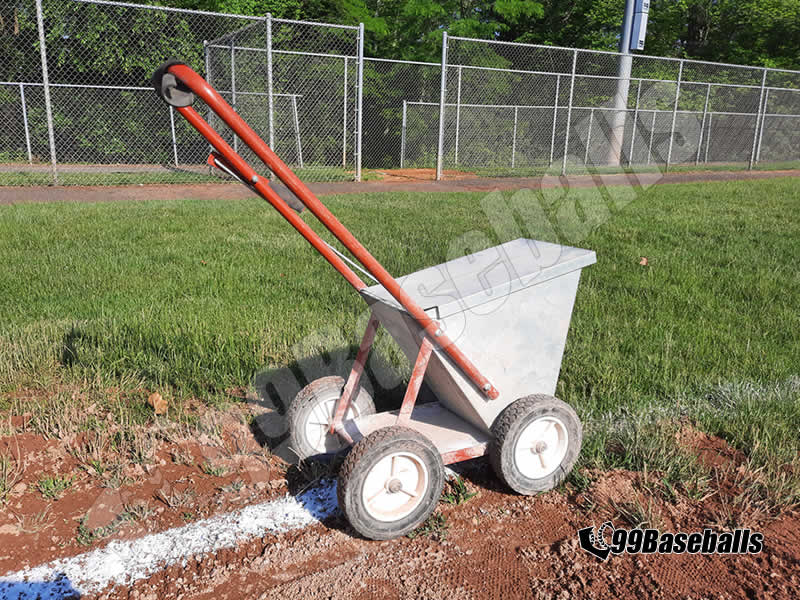
Width of the Foul Lines – the standardized thickness
Strangely, MLB has the following rules about how the foul lines are used to determine fair and foul balls, but it says nothing about the actual thickness of the foul lines:
- A FOUL BALL is a batted ball that settles on foul territory between home and first base, or between home and third base, or that bounds past first or third base on or over foul territory, or that first falls on foul territory beyond first or third base, or that, while on or over foul territory, touches the person of an umpire or player, or any object foreign to the natural ground
MLB Rule 2.00 (Definition of Terms)
- A FAIR BALL is a batted ball that settles on fair ground between home and first base, or between home and third base, or that is on or over fair territory when bounding to the outfield past first or third base, or that touches first, second or third base, or that first falls on fair territory on or beyond first base or third base, or that, while on or over fair territory touches the person of an umpire or player, or that, while over fair territory, passes out of the playing field in flight.
However, speaking with a few maintenance crews from several stadiums confirmed that the width of a foul line thickness ranges from 3 to 4 inches at professional parks.
In local youth league parks, we usually lay down 2.5-inch thick lines.
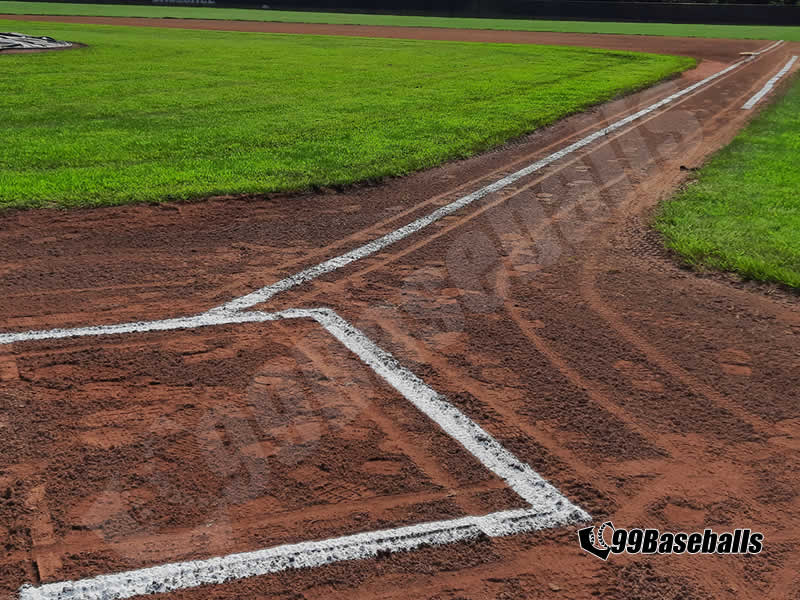
Why use thinner lines in youth leagues? For two primary reasons:
- 50/70 or smaller fields are easier to see down the foul line by a home plate umpire than 60×90 fields.
- Laying down the thinner line means less material which equates to saving money (local baseball leagues have a tight budget).
Again, four-inch lines are used in professional ballparks because stadiums are large (making it difficult for one of the field umpires to see), and plays happen at a faster rate.
Infield Foul Line Dimensions – How Far Does it Go?
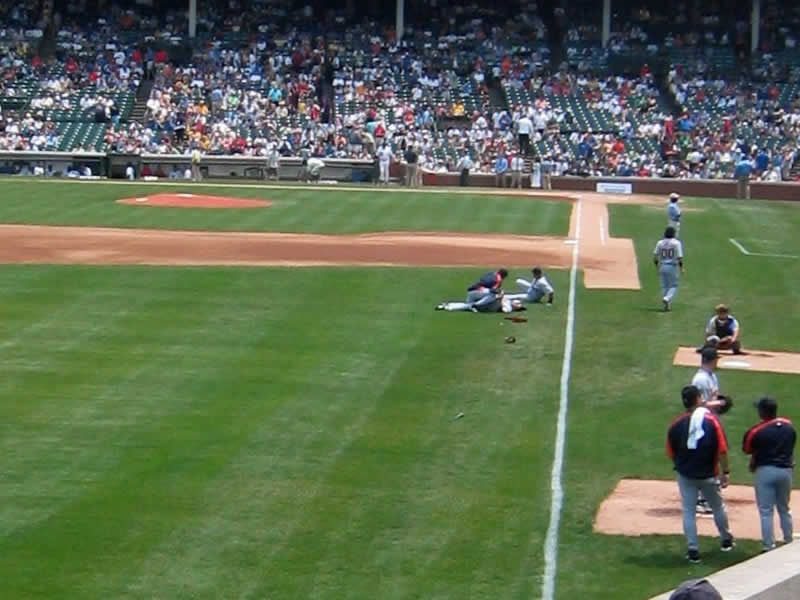
The infield portion of the foul line extends from the back point of home plate to the outer edge of first and third base, a distance of 90 feet on a regulation diamond.
Foul line from home to first or third also acts as a “visible” baseline (baselines from first to second and second to third base are invisible).
It is important to remember that the line itself as well as first base and third base are part of the fair territory.
You would think using this logic means the pitching rubber is in the fair territory, right? Wrong! If a batted ball hits the pitching rubber (without touching the ground) and the ball ends up in the fair territory, it’s a foul.
Fun Fact Did you know that when baseball diamond was first standardized, the first and third base foul lines went through the center of the bases? That meant the inner part of the base was in the fair territory and the outer portion of the base was in the foul territory! Modern field layout dictates that foul lines are painted on the outer edge of the base to remove this confusion, though the second base remains in the original location.
The Outfield Foul Line – First or Third Base to Outfield Wall
From first/third base, the foul line continues to the closest point of the outfield wall, the distance of which can vary significantly depending on the specific ballpark’s design.
Chicago Cubs’ Wrigley Field has the honor of having the deepest left and right field at 355 feet and 353 feet, respectively. That means the outfield portion of the first base foul line is 263 feet and the third base foul line is 276 feet!
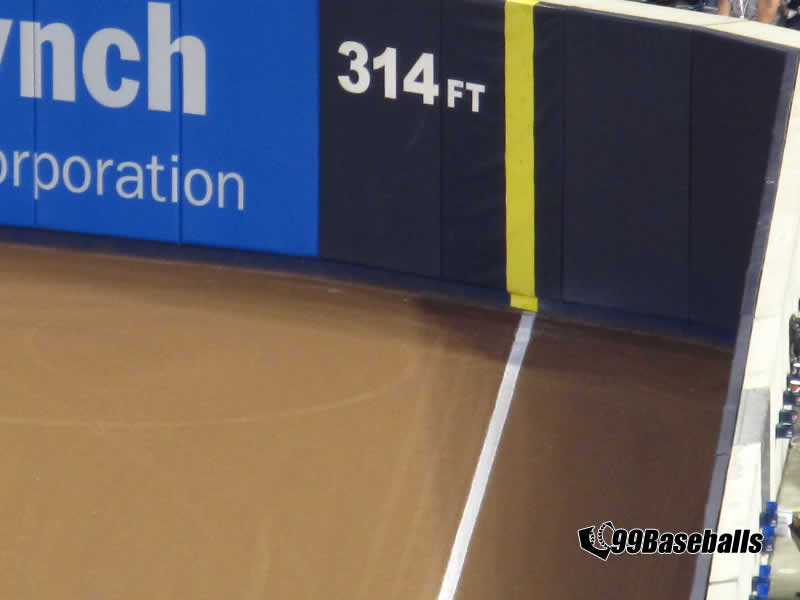
Foul Poles – Material, Height, and Positioning
Though not physically drawn, the foul line conceptually extends infinitely upward and outward from the foul pole, helping umpires judge whether balls leaving the field are fair (home runs) or foul.
Despite their name, foul poles are located in fair territory and play a crucial role in determining home runs.
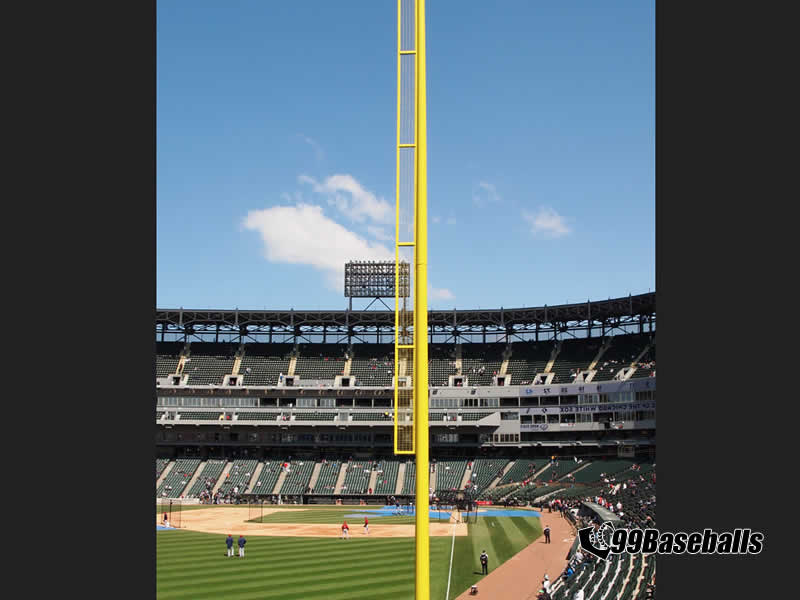
They are typically made of steel and painted bright yellow for visibility.
Their height above the outfield wall varies among ballparks but must be at least as high as the top of the outfield fence or wall.
Why is there a netting attached to the foul pole? Foul poles and pole flags are an essential reference point for umpires and netting makes it easier for them to distinguish fair ball and foul ball. If a batted ball hits the foul pole or the flag netting, or flies directly over it, it's considered a fair ball, resulting in a home run. If the nearest field umpire sees that it was a home run, he will point his index to the sky and make a circular motion to let others umpires know.
Commonly used Marking Materials
Creating the lines of a baseball field involves marking the foul lines and batter’s box with a substance that is visible and non-interfering with the play.
Historically, chalk has been commonly used to line the field in baseball. It’s a soft, white, porous sedimentary rock, a form of limestone composed of the mineral calcite. Ground up into a fine powder, chalk becomes an excellent substance for creating bright and visible lines on the field. It’s also relatively safe for players if they come into contact with it.
In the past, a type of lime called “quicklime” or “burnt lime” was also used for marking lines on fields. However, lime-based products may cause skin burns on contact when wet, so it has been phased out for such uses.
For a safer alternative, groundskeepers turned to “ground limestone” or “agricultural lime,” which is chemically different from quicklime and safe to touch. This type of lime is also white and visible on the field. However, it can be harder to apply in a fine line and may not be as bright as chalk.
In the late 20th and early 21st century, new products came onto the market called “athletic field marking dust”, made specifically for lining athletic fields. These products are designed to be highly visible with bright white “color” to improve visibility and aesthetic appearance, easy to apply, and safe for skin contact and for the environment.
Laying Down the Line – Tips for Coaches
Youth coaches not only have to coach, but sometimes have to act as a field maintenance crew to drag and line the field. I know how busy you can be so I wrote this short section just for you!
Foul Line Thickness
Most walk-behind chalker (spreader) comes with an adjustable knob to control the thickness anywhere from 2 to 4 inches.
Chalk dust storage
Athletic Field Marker bags typically come in a heavy-duty paper bag with a plastic liner.
The chalk-like dust inside is a magnet for moisture and it will start to clump when wet. Clumped up field markers will not spread evenly, making your job lot more difficult.
So make sure to keep them off the ground and store in a dry space.
Application – Field Dust or Spray Paint?
In modern baseball, both field dust and field spray paint are widely used for marking athletic fields, including baseball fields. While they share a common purpose, they have distinct characteristics, advantages, and disadvantages.
Field Dust (Chalk or Lime)
- Advantages: Field dust is easy to apply, inexpensive, and often provides a traditional look and feel to the field. It doesn’t cause any lasting impact on the grass or dirt, and it’s easy to remove or alter lines if necessary
- Disadvantages: Field dust can easily be disturbed or displaced by players, wind, or rain, which may require regular touch-ups during a game. Also, some forms of dust can be less visible under certain lighting conditions, or they may cause temporary discoloration when players come into contact with it.
Field Spray Paint
- Advantages: Field paint is highly durable and resistant to weather conditions. It offers bright, crisp lines that are highly visible under various lighting conditions. Certain paints are designed to last a long time, reducing the frequency of reapplication
- Disadvantages: Field paint is generally more expensive than field dust and requires more time and effort to apply. It can also be harder to correct mistakes or make changes once the paint has dried. If applying on dirt field, ground must be wet for the spray can to work; otherwise, it will simply blow dirt around
Your Ultimate Decision, But…
I have used both products. If possible:
- I would use a bag of field dust on the infield portion because it is easier and more forgiving to mistakes (you can reset the line)
- For the grass portion in the outfield, I prefer to use spray paint because the paint sticks to grass blades, making the line more visible (and lasts longer)
Hey Coach – Use a string!
I have seen countless times where a volunteer parent discards my suggestion and lines the field without a guide string. More often than not, this is what foul lines look like:
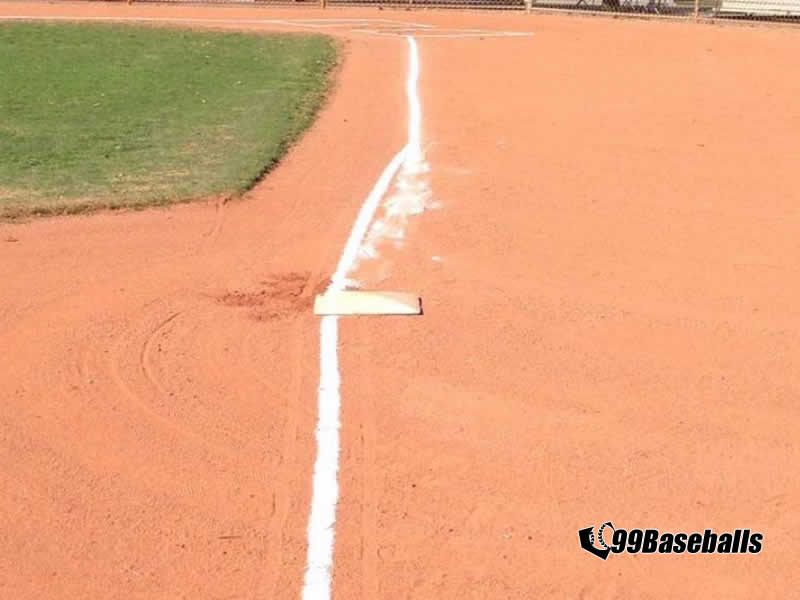
I give credit to a parent for trying to make this base part of the fair territory. But this is a third base (the line is on the left side of the batter’s box). That means the original line near the home plate was correct because the line would have included the entire third base in the fair territory.
How to properly string the foul line I highly recommend you watch the how-to-video from Beacon Athletics to learn how to string the line and laid down the chalk line.
Also, when you string a line from the home plate to first base and third base, please remember that the chalk line must be on the inside part of the string. Another words, don’t wheel your spreader with the string in the middle of the spreader or else you will get this:

If you examine the picture above closely, you’ll notice a string line running down the middle of the chalk line. The person correctly laid the string from the angled side of home plate to first base. However, he placed the chalk spreader in the middle of the string line. Of course as he got closer to first base he realized the error and moved the spreader to the left so that the chalk lined up to the right side of the first base.
Remember, we all have screwed up once or twice lining the field. If you fudge it up, “chalk it up” (pun intended) as a learning experience and do it properly next time!
Takeaways
From an outfielder making a lung-busting run to pull off an outstanding catch in foul territory to a batter trying to thread the ball just inside the line to fox the opposition, the foul lines are intrinsic to every play in baseball.
The game is steeped in complexities and understanding the intricacies lies in comprehending the role of foul lines and foul territory is what we love about baseball.
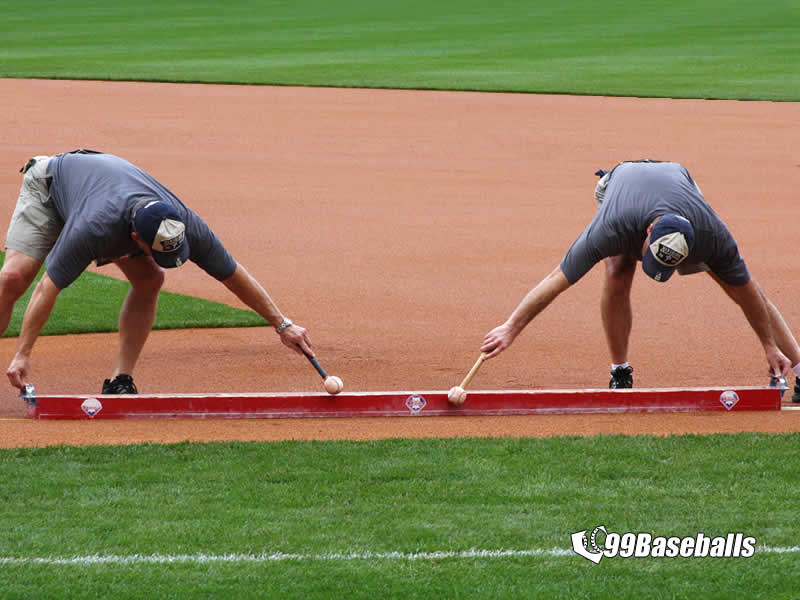
Baseball foul lines can profoundly influence the game’s dynamics, shaping the decisions of players on the field, informing the judgments of umpires, and intrigue to fans.
From the materials used to mark the lines to their dimensions and the complex fair-or-foul rules, these lines are as much a part of baseball as the players themselves.
Frequently Asked Questions (FAQ)
What are the ‘foul poles’ made of?
Foul poles, despite being located in fair territory, are generally made of sturdy materials like steel or aluminum to withstand the elements and occasional hits from baseballs. They are often painted yellow for high visibility.
Why is there an ‘imaginary line’ above the foul poles?
This ‘imaginary line’ extends infinitely upwards from the foul poles and helps umpires decide whether a high fly ball that goes over the outfield wall is a home run (if it’s within the imaginary line, thus in ‘fair’ territory) or a foul ball.
Who came up with the concept of foul lines?
The concept of foul lines has been a part of baseball since its earliest rules were formalized in the 19th century. They were introduced to clearly define the field of play.
Are all foul lines in every stadium exactly the same?
While the foul lines all serve the same purpose, their length can vary depending on the stadium’s design, particularly between the bases and the outfield wall.
What happens if a player touches a ball while standing in foul territory?
If a fielder who is standing in foul territory touches a batted ball before it has passed first or third base, it is considered a foul ball.
Is a ball that bounces off a player or an umpire in fair territory and then goes into foul territory before passing first or third base considered fair or foul?
The ball would be considered fair because it was touched in fair territory.
Are foul balls considered strikes?
Yes, foul balls are considered strikes, but with one exception: a foul ball is not considered a third strike unless it is a bunt that is not caught in flight.
How often are the foul lines redrawn during a game?
It can vary based on the conditions and specific league rules, but typically, groundskeepers will touch up the lines as needed during the game.
Are foul poles always located at the same distance from home plate in all MLB stadiums?
No, the distance from home plate to the foul poles can vary depending on the stadium’s design.
Why are some parts of the foul line marked with grass or dirt?
The area from home plate to first and third base (the infield) is often grass, while the area from first and third base to the outfield wall is typically dirt. This is due to traditional field design and how the game is played, but isn’t a requirement. The line itself should still be marked in a way that is clearly visible.




